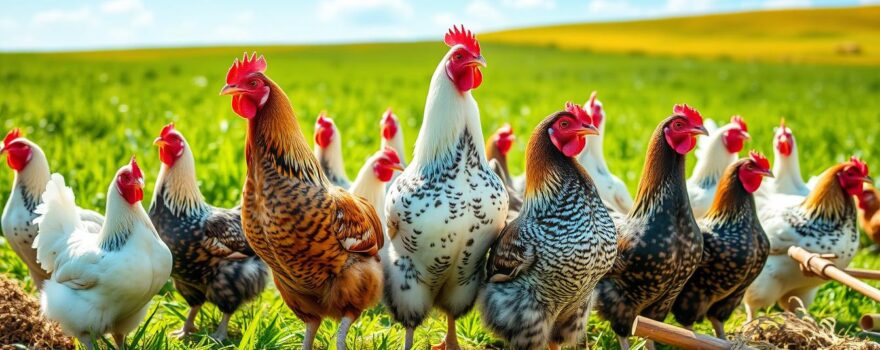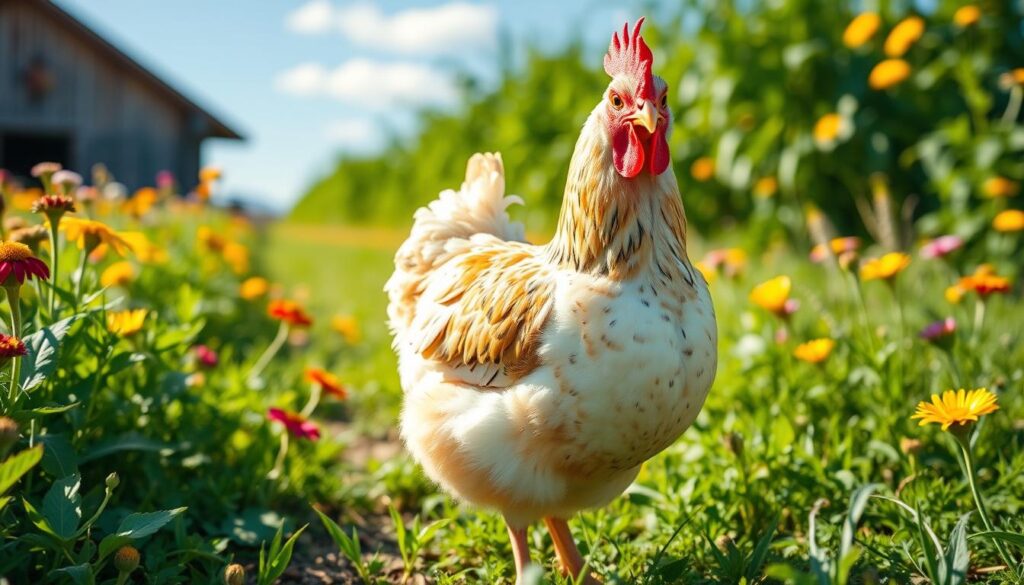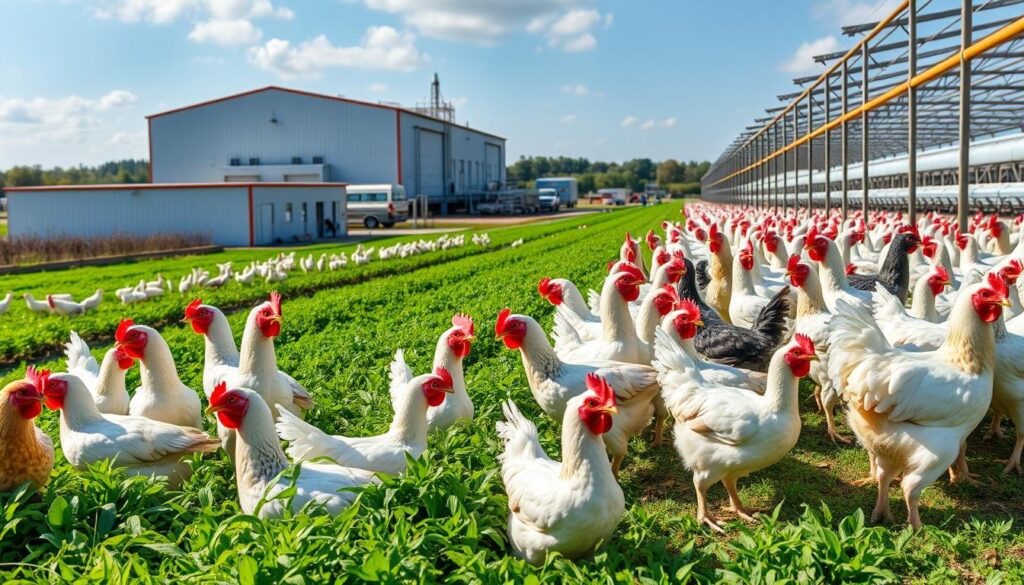
The modern broiler chicken, known as the “Cornish Cross,” has seen a huge jump in growth rate. This is thanks to intense artificial selection over the years. Today, broilers grow 300% faster than they did in 1960, reaching heavier weights in less time.
This change is mainly due to the poultry industry’s goal to improve traits like body weight and growth rate. They focus on these through selective breeding programs.
The poultry industry’s drive for efficient meat production has led to big gains in broiler growth and feed efficiency. Now, broilers reach a marketable weight of about 2kg in just 35 days. This is twice as fast as broilers 50 years ago.
This fast growth is thanks to the industry’s genetic selection for the best performance. It has made the modern broiler an “extreme organism” compared to its historical counterparts.
How Selective Breeding Has Accelerated Broiler Growth Rates
The poultry industry has seen a huge leap in broiler productivity thanks to selective breeding. Since the 1940s, breeding companies have used genetics and selection to boost traits like weight, growth, and feed efficiency. This has led to better carcass yield too.
Intense Genetic Selection for Economically Important Traits
Broiler producers have focused on fast growth, efficient feed use, and better body shape through genetic selection. This has led to a huge jump in growth rates. Now, broilers reach market weight in under 29 days, a 300% increase from the 1960s.
Improved Genetics and Breeding Account for Productivity Gains
About 80-90% of the broiler industry’s growth is thanks to better genetics and breeding. Advances in genetics and careful selection have improved broiler genetics. This has led to the impressive growth and productivity we see today.
| Trait | Improvement |
|---|---|
| Growth Rate | 300% increase over 60 years |
| Feed Efficiency | Improved by 50% since 1950s |
| Carcass Yield | Increased by 20% since 1970s |
Genetic improvement, better nutrition, and management have changed the poultry industry. Now, broiler production is one of the most efficient parts of the global food system.
The Cornish Cross: An “Extreme Organism”
The Cornish Cross chicken is now a key player in commercial broiler production. It has seen a huge jump in growth rate and body shape over the last 60 years. This Cornish Cross broiler has grown 300% faster than chickens in 1960. It now reaches heavier weights in less time, with a big breast muscle and changed body conformation.
300% Faster Growth Rate Than Chickens in 1960
The Cornish Cross broiler has grown 300% faster in 60 years. This is much faster than chickens from the 1960s. It has become an “extreme organism” in the poultry world.
Disproportionately Large Breast Muscles and Body Conformation Changes
The Cornish Cross broiler also has big body conformation changes. It has a disproportionately large breast muscle. These changes come from intense genetic selection for modern broiler breeding and production efficiency.
| Trait | Cornish Cross Broiler | Chickens in 1960 |
|---|---|---|
| Growth Rate | 300% faster | N/A |
| Breast Muscle Size | Disproportionately large | Normal |
| Body Conformation | Altered to meet production demands | Natural |

“The Cornish Cross is an ‘extreme organism’ that has undergone dramatic changes in growth rate and body conformation to meet the demands of modern broiler production.”
Muscle Architectural Changes and Locomotor Function
The intense genetic selection for rapid growth and large breast muscle in broiler chickens has significantly impacted their muscle architecture and locomotor function. Researchers have found that this selective breeding has led to a decline in the mass of the pelvic limb muscles. This may compromise the broilers’ ability to move effectively.
Decline in Pelvic Limb Muscle Mass Compromising Locomotor Abilities
The broilers’ larger body mass and disproportionately large breast muscles place greater demands on the pelvic limb muscles. This can lead to biomechanical constraints that impair their walking ability. It also contributes to musculoskeletal abnormalities and lameness. The decline in pelvic limb muscle mass is a concern, as it can negatively impact the locomotor function of these birds.
“Selective breeding has led to a fourfold increase in broiler growth rate, reducing the time-to-slaughter from 16 to 6 or fewer weeks.”
The rapid growth and increased body mass of modern broilers have placed significant strain on their broiler muscle architecture. This has led to changes that may compromise their overall health and well-being. Understanding these musculoskeletal abnormalities and their impact on lameness is crucial for addressing the welfare concerns associated with the industry’s focus on productivity and efficiency.
By addressing these issues, the industry can work towards finding a balance between productive goals and the well-being of the animals. This ensures a more sustainable and ethical approach to broiler production.
Selective Breeding in Commercial Broiler Lineages
The broiler breeding industry uses a pyramid model. It starts with a small elite group at the top and grows to a larger commercial base. Male lines focus on growth rate, edible meat yield, and feed efficiency. Female lines are chosen for growth rate, meat yield, egg production, and feed efficiency. This selective breeding aims to boost productivity and efficiency in both breeder and broiler performance.
Selection for Optimal Breeder and Broiler Performance
The traditional broiler breeding program uses a four-way cross (A, B, C, and D lineages) to create commercial hybrids. The grandparent generation (F2) includes AB males and females, as well as CD males and females. This allows for the selection of the most productive offspring. The parent generation (F3) is made up of specific male and female pairs for crossing to produce the final commercial hybrid (F4).
Selective breeding in commercial broiler lineages aims to enhance growth traits and carcass conformation. It looks at daily weight gain, feed efficiency, carcass yield, and disease resistance. For breeders, selection criteria include egg production, hatchability, and viability.
The broiler breeding pyramid helps in continuous genetic improvement. Breeders work years ahead, using sibling evaluation, family averages, and directed mating strategies. This ensures the best breeder and broiler performance.
Welfare Concerns of Accelerated Growth
The fast growth of broiler chickens has raised big welfare worries. Many broilers have trouble moving or standing because of muscle and bone problems. This issue, called lameness, is common in the broiler world.
Musculoskeletal Abnormalities and Lameness
Research shows that 30% to 57% of broilers in Europe have lameness. Only 1-2.2% have perfect gaits. This makes it hard for them to move and can lead to more health issues.
Compromised Physiological Function
The fast growth and big size of broilers also harm their health. They often face heart and lung problems. To help, farms use antibiotics, which can lead to bacteria that are hard to fight and harm human health.
Fast growth in broilers is a big welfare problem. We need a better way to raise poultry. Fixing this is key for animal health and the safety of our food system.
Concentrated Broiler Genetics Industry
The broiler genetics industry has become very concentrated. Just three major companies now control the international market. These companies provide everything farmers need, including birds, feed, and veterinary care. They also dictate how the birds should be raised.
This control has taken away consumer choice. The fast-growing Cornish Cross breed is now the standard everywhere. This means farmers have to follow strict guidelines.
Three Major Companies Dominate International Market
The top three broiler genetics companies hold a big share of the global market. They have grown strong through strategic moves like buying other companies. This has made them even more powerful.
This concentration has led to a system where farmers have little freedom. They must follow the rules set by these big companies. This limits their ability to make choices.
| Company | Global Market Share |
|---|---|
| Aviagen | 25% |
| Cobb-Vantress | 30% |
| Hubbard | 20% |
These three companies’ dominance means consumers have few choices. Farmers must use the breeds and methods these companies suggest. This limits the variety in broiler production.

“The broiler genetics industry has become so concentrated that the vast majority of the world’s chickens are now descended from the breeding stock of just a few companies.”
Alternatives to Fast-Growing Broiler Strains
While most broilers in the U.S. are Cornish Cross, there are other options. Slower-growing broiler strains and heritage breeds grow more naturally. They also have better health and movement.
In Europe, these breeds are common, but in the U.S., they’re rare. This is because of the Cornish Cross’s market dominance. Change will come from consumer demand and humane certification programs.
Slower-growing breeds offer many benefits:
- Less musculoskeletal problems and lameness
- Natural growth and better health
- Meat with a unique taste
Even though Cornish Cross is still popular, demand for better welfare is growing. This could lead to more use of slow-growing broiler strains and heritage breeds in the U.S.
“Incorporating health and welfare traits in breeding programs for fast-growing broiler strains has had limited success in reducing welfare problems.
The modern broiler industry focuses too much on speed and efficiency. This has led to the use of fast-growing chickens that can’t live well. These “Cornish Cross” birds grow much faster than chickens did in the 1960s.
They get too big too quickly. This fast growth causes many health problems. Issues include muscle issues, poor body function, and too much use of antibiotics.
There are better chicken options, but the industry mainly uses Cornish Cross. This is because the genetics of fast-growing chickens are very common. Changing this will need more people to want better chicken choices.
It’s time to think about the chickens’ health and the planet’s future. We need to balance making money with taking care of animals and the environment. This way, the poultry industry can grow in a good way.